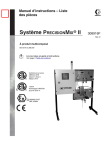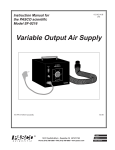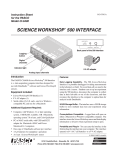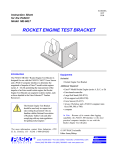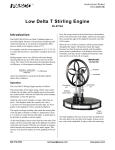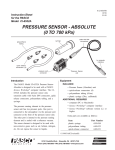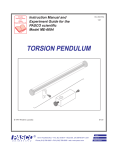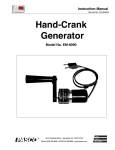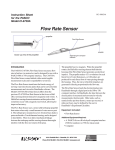Download PASCO Specialty & Mfg. ES-9042A User's Manual
Transcript
012-04393C Instruction Sheet for the PASCO Model ES-9042A Faraday Ice Pail Introduction The Ice Pail designed by Faraday is an excellent product for sampling a charge distribution. It operates on the principle that a charge placed inside a conducting surface will induce an equal charge on the outside of that surface. For example, if a charged ball were hung inside a coffee can, the charge on the outside of the can would equal the charge of the ball. The charge can be measured with an electrometer such as the PASCO Model ES-9078 Basic Electrometer. The PASCO Model ES-9042A Faraday Ice Pail is a wire mesh cylinder measuring 10 cm in diameter by 15 cm deep with a wire mesh bottom. It is mounted on three insulating rods along the outer edge of a wire mesh shield. The wire mesh shield not only ensures complete visibility of the experiment but also helps eliminate the problem of stray charges and AC fields. To prevent stray charges from producing erroneous results it is extremely important that the person performing the experiment be continually grounded while performing the experiment. The Ice-Pail needs to be temporarily grounded prior to starting the experiment. A charged object such as the PASCO Model ES-9057A Charge Producers and Proof Plane is placed in the grounded ice pail (without touching it), and the electrometer indicates the potential between the ice pail and ground. The greater the charge the greater the potential. Thus we can easily measure relative charges by varying the charges in the ice pail and observing the potential indicated by the electrometer. Complete instructions for the operation of PASCO Electrostatic equipment can be found in the ES-9051 Accessory and Demonstration Manual (included with the Demonstration System) and the ES-9055 Laboratory Manual (included with the Electrostatic Laboratory System) Charge Producer Red Clip Electrometer + + + + + + + + + + + Black Clip Faraday Ice Pail + + ++ - ++ + + - ++ + + ++ - - - - - - + - + + + + + + Figure 1 Demonstration: Faraday Ice Pail and Charge Production Since the Faraday Ice Pail is used so frequently in electrostatic demonstrations, one should examine the relationship between the charge induced on the ice pail by an inserted object and the actual charge on that object. Using the ice pail, one can then investigate the nature of charging an object by contact as opposed to charging by induction. Equipment needed: Faraday Ice Pail, charge producing objects (such as ES-9057A Charge Producers), electrometer Setup ➀ Connect the electrometer input lead (red alligator clip) to the ice pail to create a system for measuring charge. The electrometer ground lead (black alligator clip) attaches to the shield. (Setup is shown in Figure 1.) Adjust the sensitivity of the electrometer so that most readings appear in the upper 2/3 of the scale. Faraday Ice Pail 012-04393C ➤ NOTE: ➁ Ground the ice pail (i.e., connect the inner pail to the shield) by touching the inner pail and the outer shield at the same time with the finger of one hand. (See Figure 2) While conducting the experiment it may be convenient to continually rest one hand on the upper edge of the shield. This also grounds the experimenter, providing the electrometer is connected to both ground and shield and it allows the ice pail to be easily grounded whenever necessary. Closed ➀ The charged object must be inserted at least into the lower half of the ice pail. Try inserting it, for example, approximately one centimeter below the top of the pail and attempt to explain your results. ➁ There may be a small charge retained on the exposed plastic between the aluminum disk and the aluminum rod on the charge producers. This residual charge does not transfer readily when the disk is touched to the pail. Therefore, (before starting the experiment) breathe on the exposed plastic of the charge producer so that the moisture in your breath will tend to remove any residual charge. Open Procedure B ① Starting with initially uncharged charge producers, rub the blue and white materials together. Using the Faraday Ice Pail, measure the magnitude and polarity of their charges. By using the results from Procedure A it is not necessary to touch the charge producer to the pail. What relationship exists between these charges produced by contact? Figure 2 ➁ Ground the charge producers and rub them together ➤NOTE: When removing your finger from the inner pail after grounding it, make certain that you are still touching the outer shield. DO NOT remove your hand from the shield before releasing the inner pail, as this sequence will not effectively ground the inner pail. inside the ice pail. What is the reading on the electrometer. Remove one charge producer and note the electrometer reading. Replace this charge producer but remove the other and note the electrometer reading. ➂ Ground the charge producers again. Rub the white ➂ Make sure the electrometer reads “zero”, indicating material against the aluminum proof plane. Measure the magnitude and polarity of the charges. Now rub the blue material against the aluminum surface and record your measurements. that there is no charge on the ice pail. Procedure A ➀ Rub two charge producers together to create a charge ➃ Construct a list of materials such that if a material on them. lower on the list is rubbed against a material higher on the list, the charge on the higher listed material is always positive. Such a list is called an electrostatic series. ➁ Insert one of the wands into the ice pail but do not let it touch the pail. Note the electrometer reading. ➂ Remove the object from the pail and again note the To Reach PASCO electrometer reading. For Technical Support call us at 1-800-772-8700 (tollfree within the U.S.) or (916) 786-3800. ➃ Insert the wand again, allow it to touch the ice pail and then remove it. Note the electrometer reading. email: [email protected] ➄ Momentarily ground the ice pail and then touch the object to the pail again. Note the electrometer reading. Does any charge remain on the object? Tech support fax: (916) 786-3292 What is the conclusion about the induced charge on the ice pail, as compared to the charge on the charge producer? 2 ®



